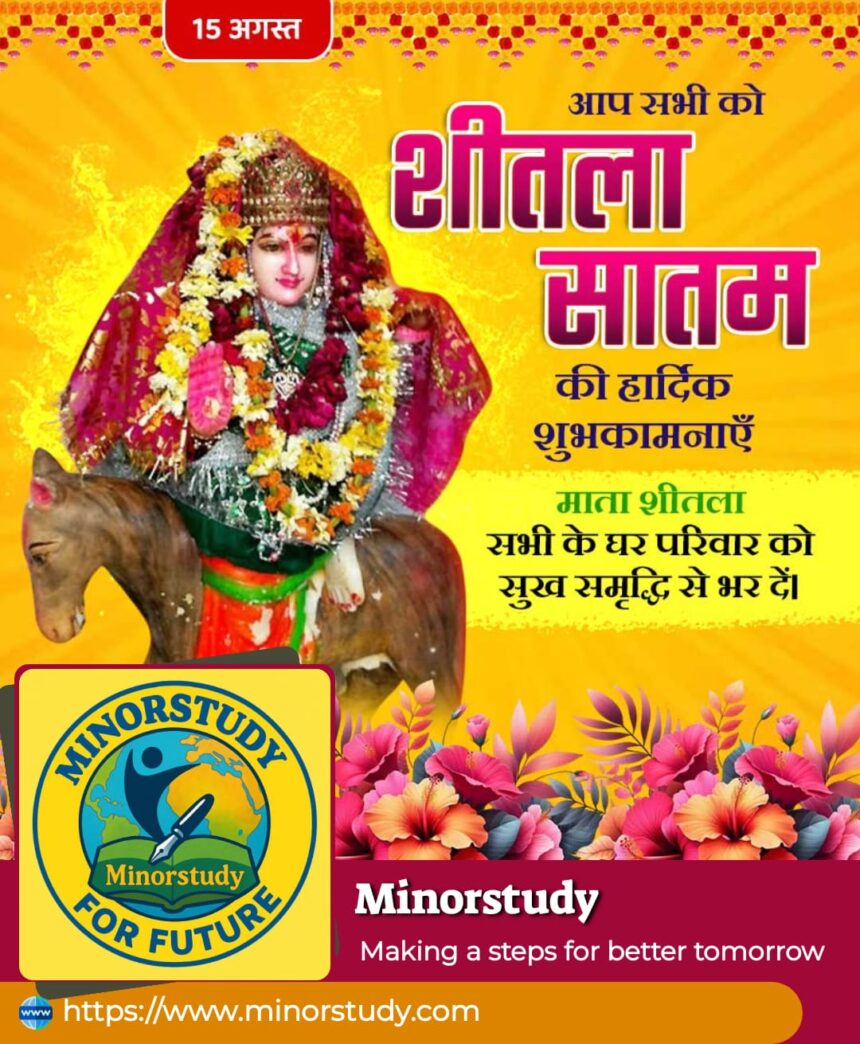Shitala Satam – History, Significance, Rituals, and Life Lessons
Introduction
In many Indian states, especially Gujarat, Rajasthan, and parts of Maharashtra, there is a unique festival where people do not cook fresh food, instead eating meals prepared a day before. This day is called Shitala Satam (or Sheetla Saptami), and it is dedicated to Goddess Shitala Mata, the divine protector from diseases like smallpox, measles, and seasonal illnesses.
Celebrated mainly during the monsoon season, Shitala Satam is more than a religious observance — it’s a blend of health awareness, traditional wisdom, and community bonding.
History of Shitala Satam
The worship of Shitala Mata has deep roots in ancient Indian traditions. The name “Shitala” comes from the Sanskrit word śītala, meaning cool or calm. She is believed to be an incarnation of Goddess Parvati or Ma Durga, who manifests in a benevolent form to protect children and families from heat-related and infectious diseases.
Historically, Shitala Mata was associated with protection from smallpox, a disease that plagued India for centuries. People believed that by pleasing the Goddess, epidemics could be prevented or cured. Over time, as medical science advanced and smallpox was eradicated, the festival’s meaning evolved into a symbolic prayer for good health and protection from seasonal ailments, especially during the rainy season when viral infections are common.
Interesting Facts About Shitala Satam
No Cooking Rule: On Shitala Satam, households prepare all meals a day before (Randhan Chhath) and eat them cold the next day.
Health Logic: Traditionally, this break from cooking gave time for cleaning kitchens and preventing contamination during monsoon.
Neem Leaves in Rituals: Neem, known for its medicinal properties, is offered to Shitala Mata and used in households to ward off germs.
Regional Variations: In Gujarat, it’s called Shitala Satam, in Rajasthan Sheetla Ashtami, and in some parts of Bengal Sheetala Puja.
Link to Monsoon Cycle: The festival falls when humidity is high and infections spread easily, reinforcing hygiene habits.
Women’s Devotion: Women usually lead the rituals, praying for the health of their children and family.
Temple Offerings: Temples dedicated to Shitala Mata are decorated with flowers, turmeric, and cold food offerings.
Timeline of Shitala Satam
| Period | Event |
|---|---|
| Ancient Times | Emergence of Shitala Mata worship as part of disease-prevention rituals |
| Medieval Era | Regional variations of the festival spread across India |
| Pre-20th Century | Worship seen as the primary remedy against smallpox outbreaks |
| Post-1977 | After smallpox eradication, focus shifts to symbolic prayers for overall health |
| Modern Day | Festival blends spiritual devotion with awareness of hygiene and seasonal wellness |
Significance of Shitala Satam
Spiritual Significance: Honors Shitala Mata, the guardian of health and wellbeing.
Health Awareness: Encourages cleanliness, hygiene, and healthy eating habits.
Cultural Heritage: Preserves centuries-old traditions in rural and urban households.
Community Bonding: Families and neighbors share pre-cooked meals, strengthening social ties.
Environmental Connection: Reducing kitchen smoke for a day helps purify the air indoors.
Observance and Rituals
Randhan Chhath (Cooking Day Before): All food for Shitala Satam is cooked a day earlier. Popular dishes include thepla, puri, batata shaak, laddoo, and khichdi.
Morning Puja: Devotees visit Shitala Mata temples, carrying cold food, turmeric, neem leaves, flowers, and sweets.
Offerings: Food is offered to the Goddess before being shared among family and friends.
Neem Ritual: Sprinkling neem-infused water in the house is believed to purify and protect from disease.
No Stove Firing: Tradition dictates avoiding lighting fire in the kitchen, symbolizing rest and respect for the Goddess.
Wishes and Greetings for Shitala Satam
English:
“May Shitala Mata bless your home with good health and happiness. Happy Shitala Satam!”
“Wishing you and your family wellness, peace, and prosperity on this sacred day.”
“May Goddess Shitala keep you cool, calm, and healthy always.”
Hindi:
“शीतला सप्तमी की हार्दिक शुभकामनाएँ! माता शीतला आपका परिवार स्वस्थ रखें।”
“शीतला माता का आशीर्वाद आपके जीवन में सुख और शांति लाए।”
“माता शीतला आपके घर को रोग और कष्ट से मुक्त करें।”
Importance of Shitala Satam in Our Life
Hygiene Practice: A break from cooking allows deep cleaning of cooking areas.
Community Togetherness: Sharing food strengthens neighborhood bonds.
Preserving Tradition: Keeps alive ancient practices linked to wellbeing.
Seasonal Wellness: Encourages dietary adjustments suited to monsoon.
Spiritual Calmness: Rituals and prayers bring mental peace and positivity.
Impact on Daily Life
Even beyond the festival, Shitala Satam teaches life lessons:
Maintain hygiene to prevent illnesses.
Value traditions that merge health with spirituality.
Take occasional breaks to rest and rejuvenate.
Respect nature’s seasonal cycles.
Keep community bonds strong through sharing and caring.
FAQs on Shitala Satam
Q1. Why is food eaten cold on Shitala Satam?
Because it’s prepared the day before as an offering to Shitala Mata, symbolizing health protection and kitchen rest.
Q2. Is Shitala Satam the same as Sheetla Ashtami?
They are similar festivals, but dates may vary regionally.
Q3. Which states celebrate Shitala Satam the most?
Primarily Gujarat, Rajasthan, Maharashtra, and parts of West Bengal.
Q4. Is the festival still relevant after smallpox eradication?
Yes — it’s now symbolic for health awareness, hygiene, and cultural identity.
Q5. What offerings are made to Shitala Mata?
Cold food, neem leaves, flowers, turmeric, and sweets.
Conclusion
Shitala Satam is more than just a ritual of eating cold food — it’s a fusion of faith, health consciousness, and cultural unity. Rooted in the belief that Goddess Shitala protects her devotees from illness, the festival also serves as a reminder of our responsibility to maintain hygiene, care for our families, and respect seasonal changes.
In a modern world where fast-paced lifestyles often make us neglect health, Shitala Satam stands as a timeless reminder that prevention is better than cure — and that community, tradition, and devotion can work hand-in-hand to keep both body and soul healthy.
May Shitala Mata bless you with coolness of mind, purity of heart, and strength of health.








